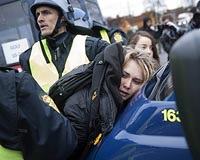| . |  |
. |
Paris (AFP) April 16, 2010 Big volcanic eruptions have had a cooling effect on Earth's climate, but the Icelandic event is too small to provide any such respite from manmade global warming, scientists said on Friday. The benchmark cooling event of the past 20 years was in 1991, when Mount Pinatubo erupted in the Philippines. It cooled Earth's surface by 0.5 degrees Celsius (0.9 degrees Fahrenheit) over the next year, enough to offset the impact of greenhouse gases from 1991 to 1993. A smaller cooling episode occurred in 1980, when Mount St. Helens in the US state of Washington blew its top, an event that while impressive disgorged only a tenth of the material of Pinatubo. The chill comes from a simple formula: The volcano spews out a huge amount of fine volcanic ash and sulphur dioxide, which are transported into the high altitude layer known as the stratosphere. There, chemistry and physics combine, creating a fine layer of whitish particles that for months or years are blown around the Earth and reflect some of the Sun's rays rather than let the radiation reach the ground. "Basically, it's like putting a reflector shield over the windscreen of your car -- you're stopping the inside of the atmosphere getting too warm," said Colin Macpherson of Durham University, northeastern England. But he and others said the eruption at Iceland's Eyjafjallajokull glacier so far was too small, did not have sufficient sulphur content and its plume circulated at too low an altitude to make an impact. Any effect will be "very insignificant," said Scylla Sillayo of the World Meteorological Organisation (WMO) in Geneva. "At the moment, we are looking at something that's about 100 times smaller than Mount St. Helen's. At the scale it's at now, it's relatively unlikely that it will have any perceptible effect on climate," explained Kathryn Goodenough of the British Geological Survey (BGS). Emmanuel Bocrie of the French weather service, Meteo France, added: "With Pinatubo, ash rose to 18,000 metres (58,500 feet), in the tropics. "It's not at all the same situation in this case, where the plume is at an average of 6,000 metres (20,000 feet), with peaks of 11,000 metres (35,750 feet). In addition, this is in a zone of the atmosphere [the troposphere] where there are powerful winds, which have a huge dispersing effect." The scientists said the Eyjafjallajokull eruption could have a regional effect on Europe's climate -- but only provided it went on for a matter of years. "Back in the 1780s, a large eruption in southern Iceland went on for a couple of years and generated a lot of sulphur," said Macpherson. "It caused a smog that was really rather nasty, there was a failure of crops as a result of acid rain, the air quality was really very poor. But that took the better part of two years to cause that kind of effect and certainly we are not looking at anything like that right now." Another is a theory -- but no more than that -- that the present eruption could touch off a far larger, neighbouring volcano called Katla. From 1821-1823, the present volcano erupted on and off, and at the end of the cycle, Katla erupted. "People have suggested there may be links between them, through fissures, but it's important to emphasise there is no proof the one would trigger the other," Goodenough said. Volcanic cooling is in any case only a temporary brake on the effects of manmade greenhouse gases, blamed for stoking dangerous change to the climate system. Earth's surface temperature rose by 0.74 C (1.3 F) from 1906-2005, the UN's Intergovernmental Panel on Climate Change (IPCC) says. In the last half-century of that period, the warming doubled, to around 0.13 C (0.23 F) per decade. Another downside is that the volcano material in the stratosphere damages Earth's ozone shield against ultraviolet radiation.
Share This Article With Planet Earth
Related Links Climate Science News - Modeling, Mitigation Adaptation
 Sick climate: Wounds of Copenhagen still fester
Sick climate: Wounds of Copenhagen still festerBonn (AFP) April 12, 2010 It was cast as a chance to revamp the UN arena on climate change, to rebuild trust and foment new thinking after the backbiting and sterility of the Copenhagen Summit last December. Instead, three days of talks here under the UN Framework Convention on Climate Change (UNFCCC) at times resembled the movie "Groundhog Day," where a grumpy skeptic is doomed to live the same events over and over ... read more |
|
| The content herein, unless otherwise known to be public domain, are Copyright 1995-2010 - SpaceDaily. AFP and UPI Wire Stories are copyright Agence France-Presse and United Press International. ESA Portal Reports are copyright European Space Agency. All NASA sourced material is public domain. Additional copyrights may apply in whole or part to other bona fide parties. Advertising does not imply endorsement,agreement or approval of any opinions, statements or information provided by SpaceDaily on any Web page published or hosted by SpaceDaily. Privacy Statement |